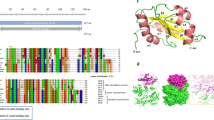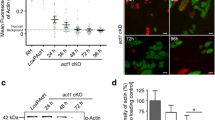Abstract
The actin cytoskeleton of host cells has been implicated in Cryptosporidium invasion. However, the underlying mechanism of how actin filaments and associated proteins modulate this process remains unclear. In this study, we use in vitro cultured cell lines, human ileocecal adenocarcinoma HCT-8 and Chinese hamster ovary (CHO), and an in vivo mouse model to investigate the roles of tropomyosin isoforms in Cryptosporidium invasion. Using isoform-specific monoclonal antibodies, we found that the major human tropomyosin (hTM) isoforms expressed in HCT-8 cells are hTM4 and hTM5. HCT-8 cells also express hTM1 at low levels but not hTM2 and hTM3. During Cryptosporidium parvum infection, hTM5 colocalized to the infection sites with a novel parasite membrane protein, CP2. Neither hTM1 nor hTM4 accumulated at infection sites. Similarly, a high level of TM5 and varying amounts of TM4 accumulated at the C. parvum infection sites in CHO cells. CHO cells overexpressing hTM5 exhibit a significantly higher percent of mature meronts early in the infection process relative to CHO cells or CHO cells overexpressing a tropomyosin mutant, chimeric isoform hTM5/3. These results suggest that functional TM5 enhances Cryptosporidium invasion of host cells. In C. parvum-infected mice, accumulation and rearrangement of TM5 and TM4 were detected throughout the infected ileum. Similarly, in the Cryptosporidium muris-infected mice, TM5 accumulated in discrete regions of the epithelial cells of gastric glands and in the oocyst-laden stomach gland lumen. Cryptosporidium infection appears to rearrange and recruit host TM isoforms in both culture cells and in the mouse. Localized accumulation of tropomyosin at the infection sites may facilitate parasite invasion.







Similar content being viewed by others
References
Blanchoin L, Pollard TD, Hitchcock-DeGregori SE (2001) Inhibition of the Arp2/3 complex nucleated actin polymerization and branch formation by tropomyosin. Curr Biol 11:1300–1304
Bonnin A, Lapillonne A, Petrella T, Lopez J, Chaponnier C, Gabbiani G, Robine S, Dubremetz JF (1999) Immunodetection of the microvillous cytoskeleton molecules villin and ezrin in the parasitophorous vacuole wall of Cryptosporidium parvum (Protozoa : Apicomplexa). Eur J Cell Biol 78:794–801
Bryce NS, Schevzov G, Ferguson V, Percival JM, Lin JJC, Matsumura F, Bamburg JR, Jeffrey PL, Hardeman EC, Gunning P, Weinberger RP (2003) Specification of actin filament function and molecular composition by tropomyosin isoforms. Mol Biol Cell 14:1002–1016
Chen XM, Splinter PL, Teitz PS, Huang BQ, Billadeau DD, LaRusso NF (2004) Phosphatidylinositol 3-kinase and frabin mediate Cryptosporidium parvum cellular invasion via activation of Cdc42. J Biol Chem 279:31671–31678
DesMarais V, Ichetovkin I, Condeelis J, Hitchcock-DeGregori SE (2002) Spatial regulation of actin dynamics: a tropomyosin-free, actin-rich compartment at the leading edge. J Cell Sci 115:4649–4660
Elliott DA, Clark DP (2000) Cryptosporidium parvum induces host cell actin accumulation at the host–parasite interface. Infect Immun 68:2315–2322
Elliott DA, Coleman DJ, Lane MA, May RC, Machesky LM, Clark DP (2001) Cryptosporidium parvum infection requires host cell actin polymerization. Infect Immun 69:5940–5942
Forney JR, DeWald DB, Yang SG, Speer CA, Healey MC (1999) A role for host phosphoinositide 3-kinase and cytoskeletal remodeling during Cryptosporidium parvum infection. Infect Immun 67:844–852
Geng X, Biancone L, Dai HH, Lin JJ, Yoshizaki N, Dasgupta A, Pallone F, Das KM (1998) Tropomyosin isoforms in intestinal mucosa: production of autoantibodies to tropomyosin isoforms in ulcerative colitis. Gastroenterology 114:912–922
Godwin TA (1991) Cryptosporidiosis in the acquired-immunodeficiency-syndrome—a study of 15 autopsy cases. Hum Pathol 22:1215–1224
Gruenheid S, Finlay BB (2003) Microbial pathogenesis and cytoskeletal function. Nature 422:775–781
Gunning P, Weiberger R, Jeffrey P, Hardeman E (1998) Isoform sorting and the creation of intracellular compartments. Annu Rev Cell Dev Biol 14:339–372
Hannan AJ, Schevzov G, Gunning P, Jeffrey PL, Weinberger RP (1995) Intracellular localization of tropomyosin messenger RNA and protein is associated with development of neuronal polarity. Mol Cell Neurosci 6:397–412
Hegmann TE, Lin JLC, Lin JJC (1989) Probing the role of nonmuscle tropomyosin isoforms in intracellular granule movement by microinjection of monoclonal antibodies. J Cell Biol 109:1141–1152
Heimann K, Percival JM, Weinberger RP, Gunning P, Stow JL (1999) Specific isoforms of actin-binding proteins on distinct populations of Golgi-derived vesicles. J Biol Chem 274:10743–10750
Hook J, Lemckert F, Qin H, Schevzov G, Gunning P (2003) Gamma tropomyosin gene products are required for embryonic development. Mol Cell Biol 24:2318–2323
Ishikawa R, Yamashiro S, Matsumura F (1989) Differential modulation of actin severing activity of gelsolin by multiple isoforms of cultured rat cell tropomyosin: potentiation of protective ability of tropomyosins by 83-KDa nonmuscle caldesmon. J Biol Chem 264:7490–7497
Kesari KV, Yoshizaki N, Geng X, Lin JJ-C, Das KM (1999) Externalization of tropomyosin isoform 5 in colon epithelial cells. Clin Exp Immunol 118:219–227
Laemmli UK (1970) Cleavage of structural proteins during the assembly of the head of bacteriophage T4. Nature 227:680–685
Lees-miller JP, Helfman DM (1991) The molecular basis for tropomyosin isoform diversity. Bioessays 13:429–437
Li Y, Lin JL-C, Reiter RS, Daniels K, Soll DR, Lin JJ-C (2004) Caldesmon mutant defective in Ca2+-calmodulin binding interferes with assembly of stress fibers and affects cell morphology, growth and motility. J Cell Sci 117:3593–3604
Lin JJ-C, Yamashiro-Matsumura S, Matsumura F (1984) Microfilaments in normal and transformed cells: changes in the multiple forms of tropomyosin. Cancer Cells 1:57–65
Lin JJC, Chou CS, Lin JLC (1985) Monoclonal antibodies against chicken tropomyosin isoforms: production, characterization, and application. Hybridoma 4:223–242
Lin JJC, Hegmann TE, Lin JLC (1988) Differential localization of tropomyosin isoforms in cultured nonmuscle cells. J Cell Biol 107:563–572
Lin JJC, Warren KS, Wamboldt DD, Wang T, Lin JL-C (1997) Tropomyosin isoforms in nonmuscle cells. Int Rev Cytol 170: 1–38
Lumadue JA, Manabe YC, Moore RD, Belitsos PC, Sears CL, Clark DP (1998) A clinicopathologic analysis of AIDS-related cryptosporidiosis. Aids 12:2459–2466
Marcial MA, Madara JL (1986) Cryptosporidium: cellular localization, structural analysis of absorptive cell–parasite membrane–membrane interactions in guinea pigs, and suggestion of protozoan transport by M cells. Gastroenterology 90:583–594
Novy RE, Sellers JR, Liu LF, Lin JJC (1993) In vitro functional characterization of bacterially expressed human fibroblast tropomyosin isoforms and their chimeric mutants. Cell Motil Cytoskeleton 26:248–261
O’Hara SP, Yu JR, Lin JJ (2004) A novel Cryptosporidium parvum antigen, CP2, preferentially associates with membranous structures. Parasitol Res 92:317–327
Onuma EK, Amenta PS, Ramaswamy K, Lin JJ-C, Das KM (2000) Autoimmunity in ulcerative colitis (UC): a predominant colonic mucosal B cell response against human tropomyosin isoform 5. Clin Exp Immunol 121:466–471
Pelham JRJ, Lin JJ-C, Wang Y-L (1996) A high molecular mass non-muscle tropomyosin isoform stimulates retrograde organelle transport. J Cell Sci 109:981–989
Percival JM, Thomas G, Cock TA, Gardiner EM, Jeffrey PL, Lin JJC, Weinberger RP, Gunning P (2000) Sorting of tropomyosin isoforms in synchronised NIH 3T3 fibroblasts: evidence for distinct microfilament populations. Cell Motil Cytoskeleton 47:189–208
Pittenger MF, Kazzaz JA, Helfman DM (1994) Functional properties of nonmuscle tropomyosin isoforms. Curr Opin Cell Biol 6:96–104
Schevzov G, Gunning P, Jeffrey PL, TemmGrove C, Helfman DM, Lin JJC, Weinberger RP (1997) Tropomyosin localization reveals distinct populations of microfilaments in neurites and growth cones. Mol Cell Neurosci 8:439–454
Taniguchi M, Geng X, Glazier KD, Dasgupta A, Lin JJ-C, Das KM (2001) Cellular immune response against tropomyosin isoform 5 in ulcerative colitis. Clin Immunol 101:289–295
Temm-Grove CJ, Jockusch BM, Weinberger RP, Schevzov G, Helfman DM (1998) Distinct localizations of tropomyosin isoforms in LLC-PK1 epithelial cells suggests specialized function at cell–cell adhesions. Cell Motil Cytoskeleton 40: 393–407
Vieira M, Dutra JMF, Carvalho TMU, Cunhae-Silva NL, Souto-Padron T, Souza W (2002) Cellular signaling during the macrophage invasion by Trypanosoma cruzi. Histochem Cell Biol 118:491–499
Warren RH, Gordon E, Azarnia R (1985) Tropomyosin in peripheral ruffles of cultured rat kidney cells. Eur J Cell Biol 38:245–253
Warren KS, Lin JL, Wamboldt DD, Lin JJ (1994) Overexpression of human fibroblast caldesmon fragment containing actin−, Ca2+/calmodulin−, and tropomyosin-binding domains stabilizes endogenous tropomyosin and microfilaments. J Cell Biol 125: 359–368
Warren KS, Lin JL, McDermott JP, Lin JJ (1995) Forced expression of chimeric human fibroblast tropomyosin mutants affects cytokinesis. J Cell Biol 129:697–708
Wong K, Wessels D, Krob SL, Matveia AR, Lin JL-C, Soll DR, Lin JJ-C (2000) Forced expression of a dominant-negative chimeric tropomyosin causes abnormal motile behavior during cell division. Cell Motil Cytoskeleton 45:121–132
Yoshikawa H, Iseki M (1992) Freeze-fracture study of the site of attachment of Cryptosporidium muris in gastric glands. J Protozool 39:539–544
Yu JR (1998) Distribution of actin and tropomyosin in Cryptosporidium muris. Korean J Parasitol 36:227–234
Yu JR, O’Hara SP, Lin JLC, Dailey ME, Cain G, Lin JJC (2002) A common oocyst surface antigen of Cryptosporidium recognized by monoclonal antibodies. Parasitol Res 88:412–420
Acknowledgement
We would like to thank Robbin Eppinga for valuable suggestions throughout this study and critical reading of the manuscript. This work was supported by grant HD18577 from the National Institutes of Health.
Author information
Authors and Affiliations
Corresponding author
Rights and permissions
About this article
Cite this article
O’Hara, S.P., Lin, J.JC. Accumulation of tropomyosin isoform 5 at the infection sites of host cells during Cryptosporidium invasion. Parasitol Res 99, 45–54 (2006). https://doi.org/10.1007/s00436-005-0117-4
Received:
Accepted:
Published:
Issue Date:
DOI: https://doi.org/10.1007/s00436-005-0117-4




